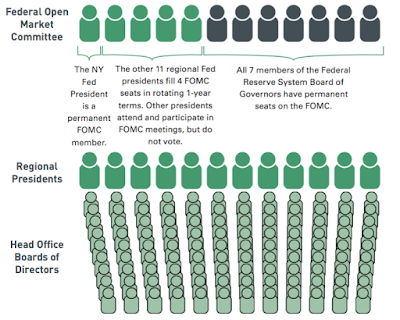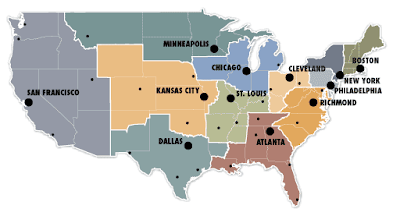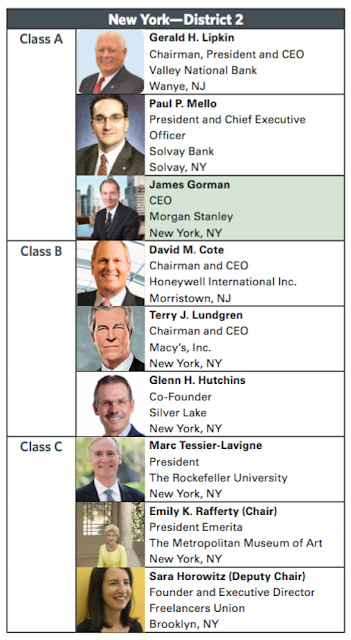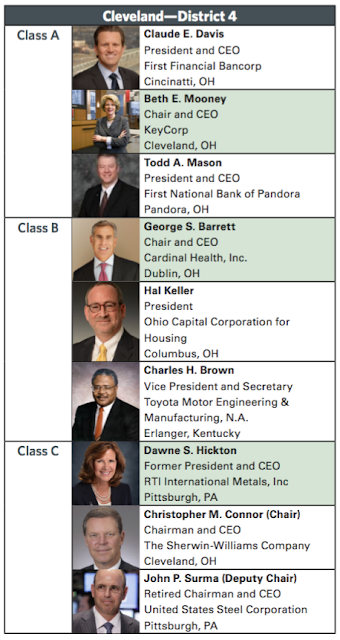In part one of this two-part posting, I looked at the gender bias at the Federal Reserve, showing how men vastly outnumber women in key posts at Federal Reserve Banks throughout the United States despite the Fed's Congressional mandate. In part two of this posting, I want to take an additional look at the Fed's bias; its failure to represent the economic diversity of America.
For those of you that either didn't read part one or who are unaware of the Federal Reserve's organizational setup, here is a graphic from a report by the Center for Popular Democracy showing the link between the Federal Reserve and its Federal Open Market Committee (FOMC) and its district banks known as Federal Reserve Banks:
Here is a map showing the regions covered by each of the 12 district banks (Federal Reserve Banks) and the 24 branches within each district:
Note that Alaska and Hawaii are covered by the San Francisco district.
If we start at the top of the organizational chart, the seven members of the Federal Reserve Board of Governors are appointed by the President and confirmed by the Senate for a 14-year term of office. The President (and Senate) also confirm two members of the Board to be Chair (currently Janet Yellen) and Vice Chair for four year terms. The FOMC consists of 12 members; the seven aforementioned Board members, the president of the Federal Reserve Bank of New York and four other regional Federal Reserve Bank presidents on a rotating, one-year term basis. The Federal Reserve Banks form an important link between the Federal Reserve and their local economy and help to dictate the Federal Reserve's monetary policies. Each of the twelve district banks has their own president and boards of directors (nine directors in total for each bank); in addition, each of the 24 district branches has its own directors (seven directors in total for each branch). The Board of Directors for each Reserve Bank are appointed in two ways; the majority are appointed by the Reserve Bank and the remainder are appointed by the Federal Reserve's Board of Governors. The directors for each district bank then appoint their own president and vice president. It all sounds rather nepotistic, doesn't it?
By law, under the Federal Reserve Reform Act of 1977, the Boards of Directors of the Federal Reserve are to be
"…elected with due but not exclusive consideration to the interests of agriculture, commerce, industry, services, labor and consumers.".
That is, each of the leaders/directors of the world's most influential central bank and its district banking system are to represent a wide variety of each of the economic sectors that make up the American economy.
The report by the Center for Popular Democracy compares the economic sector representation during the period from 2006 to 2010 when the Government Accountability Office examined the composition of the Federal Reserve Bank Boards and the present. Here is a graphic showing the past and present composition:
In both 2006 to 2010 and 2016, directors from the banking sector filled over one-third of the board seats, growing by 3 percentage points over the timeframe of the study. In combination, in 2016, representatives from the commercial and industrial sector and the banking sector filled 68 percent of seats, up from 63 percent in 2006 to 2010. The service sector's representation fell from 26 percent of seats to 18 percent and agriculture and food processing saw their representation fall from 6 percent of seats to 3 percent. Interestingly, even though they are relatively poorly represented compared to the other sectors, the number of directors affiliated with consumer and community organizations rose from 3 percent to 8 percent.
For your illumination, here are a few of the Directors for each of the Federal Reserve Banks that you can get a sense of who is dictating America's monetary policies:
If you are interested in who is on the boards of the other Federal Reserve Banks, please see the original report.
Interestingly, during the "financial crisis" of 2008, there was some question about directors' independence and actions taken by the Federal Reserve banks since there was at least the perception of conflicts of interest when director-affliated institutions took part in the Federal Reserve System's emergency programs. With a preponderance of representation from the banking and commercial sectors, it certainly doesn't take a genius to figure out which sectors of the economy will likely be favoured by Federal Reserve policies should there be another "financial crisis", does it?
Click HERE to read more of Glen Asher's columns
You can publish this article on your website as long as you provide a link back to this page.








Be the first to comment